The Mazda Museum: A Story of “Never stop challenging”

Maria Takechi, PR Consulting Dentsu Inc.
Mazda is headquartered in Hiroshima. Mazda Museum, operated by the company, is located on the same site. Mazda is a carmaker that resumed production of three-wheeled trucks only four months after an atomic bomb was dropped on the city and devastated the area. This article looks at the museum, which tells the story of Mazda’s indomitable spirit, “Never stop challenging,” and passion for manufacturing cars.
Mazda Museum was established in 1994 and renovated on the 85th anniversary of the company’s founding in 2005. A second reopening was scheduled for its 100th anniversary in January 2020 but was postponed due to COVID-19 and opened to the public in May 2022. The museum is located on the vast grounds of Mazda’s headquarters, several tens of times the size of Mazda Stadium, and has two floors with a total floor space of 3,645 square meters. It is adjacent to a part of one of the plant buildings, and the production line is included in the museum’s exhibition area. The museum has long functioned as a place where visitors can deepen their understanding of Mazda’s thoughts on car manufacturing and corporate activities and as a social and community contribution facility that responds to the needs of the educational field. The revamping of the museum for the 100th anniversary has transformed it into a place where visitors can better experience Mazda’s values and thoughts.
After gathering in the headquarters lobby, visitors board a special bus to the museum, where they see many plant buildings that represent Mazda today. Assembling and transport—that is where the museum experience begins. On the way, visitors see a row of buildings with roofs and walls identical to those in the prewar factory photos that will later be viewed at the museum, in a moment when they can experience firsthand Mazda’s history, created in the region.
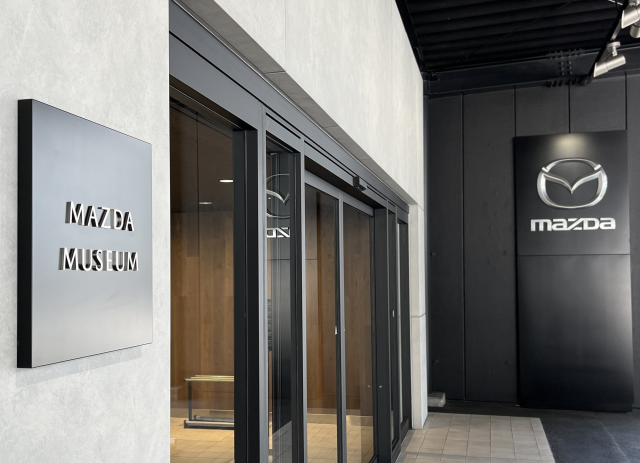
Entrance to Mazda Museum (Photo taken by the writer)
Mazda’s beginning
Mazda began in 1920 when Jujiro Matsuda and local businessmen founded Toyo Cork Kogyo Co. Ltd.
The following year, Matsuda became the second president of Toyo Cork Kogyo and got production on track, but the plant suffered a major fire in 1925. Having apprenticed at a blacksmith in Osaka since the age of 13, Matsuda had worked at various plants to hone his skills. Through rebuilding the Toyo Cork Kogyo factory, he began aiming to contribute to society through industry and changed the company name to Toyo Kogyo Co., Ltd. in 1927. In 1931, he built a new plant in Fuchu-mura (now Fuchu-cho) near his hometown and entered the automobile industry with the launch of the Mazda-Go Type DA three-wheeled truck. To answer the need for transportation after the Great Kanto Earthquake in 1923, Matsuda considered it his mission to introduce a product that would be affordable and created three-wheeled trucks instead of expensive four-wheeled vehicles.
The Pacific War later broke out and the plant was designated as a munitions factory, but three months after the war ended in 1945, its conversion to civilian use was approved. A month later, it resumed production of its three-wheeled trucks. However, the venue was Hiroshima. The world’s first atomic bomb was dropped on the city in August that year and devastated it. That was where Matsuda resumed his operations, and that is the type of indomitable spirit and “Never stop challenging” that has continued to be deeply rooted at Mazda since its foundation.
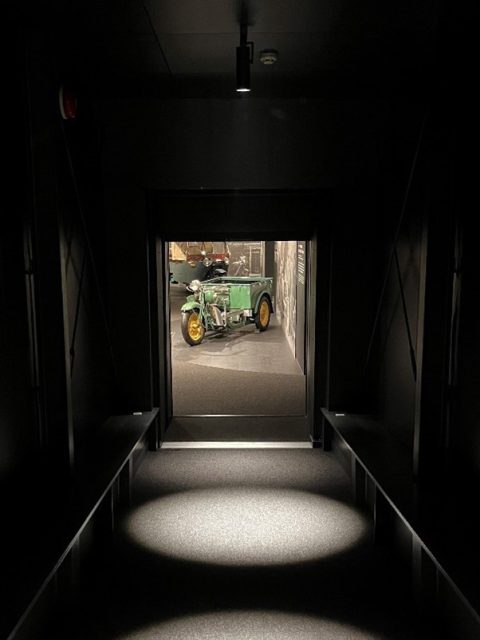
At the end of the corridor is Zone 1, a scene from the era of Jujiro Matsuda, the true founder of the company (Photo taken by the writer)
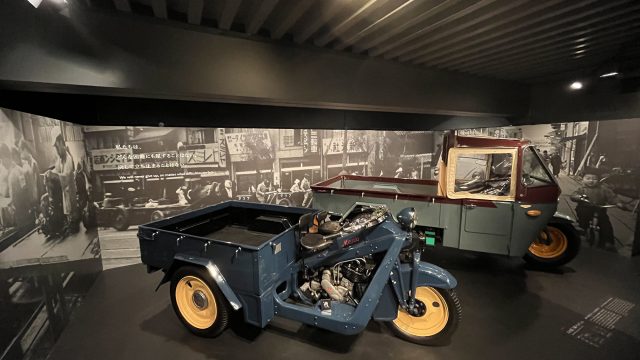
Three-wheeled Type GB truck *Production of the Type GA was resumed four months after the end of World War II. Type GB was remodeled and went on sale after the war. (Photo taken by the writer)
Exhibiting stories, not cars
The major highlight of the museum renewal, Director Hiroyuki Sukemitsu stresses, is an exhibit of the story of Mazda’s history dating back a century. He says the museum is conscious of giving visitors a sense of Mazda’s passion for making cars rather than showcasing its amazing technology.
The museum is divided into ten zones, which tell the story of Mazda’s manufacturing philosophy through the vehicles it has offered and vehicles of the future. Zones 1 to 6 are exhibits representing the past, 7 and 8 are the present, 9 is the production line, and Zone 10 is Mazda’s vision for the next 100 years.
Zone 1: 1920-1959—The Origin of Mazda’s Manufacturing Spirit (Monotsukuri)
Zone 2: 1960-1969—Transformation into a General Automobile Manufacturer
Zone 3: 1970-1985—Becoming an International Business While Responding to the Changing Times
Zone 4: Motorsports—Making a Name for Mazda and our Technology on the World Stage
Zone 5: 1986-1995—Going on the Offensive, Aiming for Growth
Zone 6: 1996-2009—Emphasizing Brand Strategy, New Plan for Growth
Zone 7: 2010-the present—Aiming for the World’s Best Cars with Mazda-unique Design and Technology
Zone 8: Technology—Monotsukuri That Puts People First
Zone 9: Assembly line—Creating Quality Cars for Each Customer
Zone 10: Toward the next 100 years—Co-creating with Others
In addition to captions, the exhibits in each zone are accompanied by photos representing current affairs, words from management and employees, and videos of employees engaging in car-making activities, all arranged in line with the periods of the exhibits.
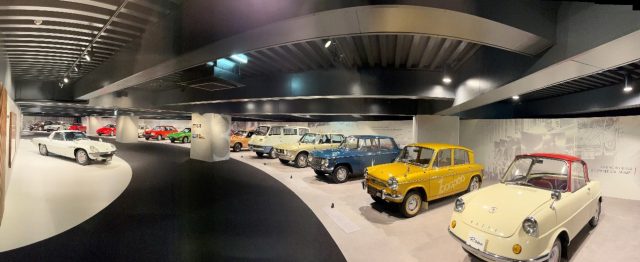
Zone 1: The Origin of Mazda’s Manufacturing Spirit (Monotsukuri) and Zones 2 through 6 display the past. Cars are displayed with photos of the times and words and images of employees as a backdrop (Photo taken by the writer)
The scripts that explain the displays also have a storyline. For example, with the Eunos Roadster (a lightweight sports car that sold explosively when launched in 1989), thoughts of the development leader at the time are shared: “A sports car is not just about being fast; it must also be fun to drive; fun to move around in.”
The Zone 7 exhibit, an opening chapter in Monotsukuri Innovation (manufacturing innovation) in technology and design, also has a story. Having overcome many difficulties, Mazda’s most recent turning point came after the global financial crisis in 2008. It is no exaggeration to say that the brand was reborn through technology and design with the banner, Monotsukuri Innovation.
Three eye-catching vehicles in distinctive red are aligned in Zone 7. At the entrance to this area is a photograph of a person surrounded by many car parts with the words, “Creating the world’s best car.” Pictured is Kiyoshi Fujiwara, who retired as vice president in June 2022. He is shown seated in the middle of tens of thousands of parts from a disassembled car to inspire his imagination to create again and to invent again what Mazda needs to offer the world today.
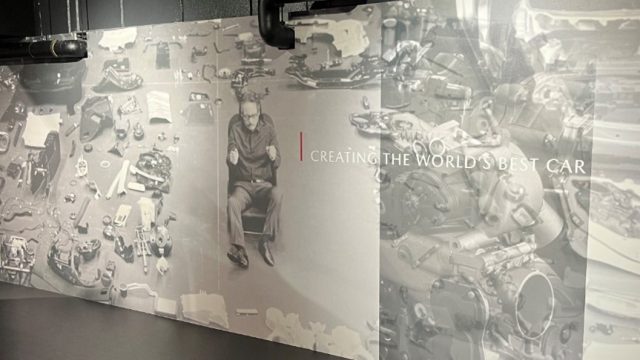
A wall at the entrance to Zone 7 with the words, “Creating the world’s best car”
Public relations and multiple other departments collaborate on a new design
The revamped design for the exhibition of these stories was undertaken by a system where the General Affairs Department took charge of planning and progress, departments related to each presentation were in charge of reviewing the content, and the Design Division supervised the display methods. Centennial Publication Editorial Office reviewed exhibits in Zones 1 through 7, Development/Production handled Zone 8, the Hiroshima Plant checked Zone 9, and the Design Division was responsible for Zone 10.) Mazda uses the expression, breathing life into cars, and the memorable experience it has made this museum is signature Mazda.
Symbols for "Never stop challenging" and behind the scenes in production
Mazda’s spirit of “Never stop challenging” has been ingrained in the company since its founding. Mazda has introduced many wonderful vehicles to the world through its countless “Never stop challengings”, and here are the symbols and what goes on behind the scenes of these challenges.
First, as a symbol, there is the 787B, which won 24 Hours of Le Mans in 1991. Zones 2 through 6 encompass Mazda’s birth as an automobile manufacturer to overcoming its business crisis after the burst of the economic bubble through the development of its brand message, Zoom-Zoom, the emotion youngsters feel towards motion. This area also introduces rotary engines for cars that Mazda succeeded in mass-producing for the first time in the world.
A rotary engine derives its power from the rotation of the rotor, and although a disadvantage is poor fuel economy compared to the conventional reciprocating engine (which converts the reciprocating motion of the piston inside the cylinder into rotational motion), it is compact, lightweight, and has high output despite its small displacement. Mazda never stopped challenging to advance the rotary engine and achieved the world’s first 24 Hours of Le Mans victory with a rotary engine and the first by a Japanese manufacturer. The 787B is displayed here, along with the rotary engine installed in the car.
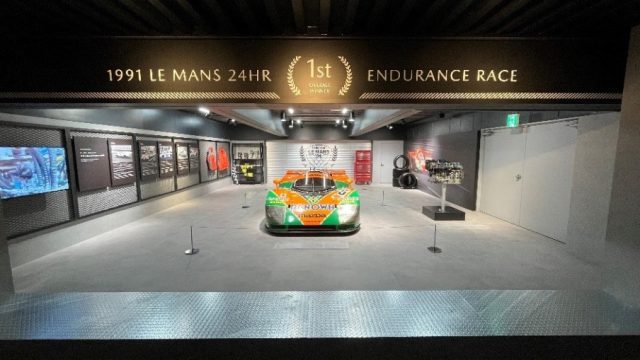
The 787B, which won 24 Hours of Le Mans in 1991 (Photo taken by the writer)
A behind-the-scenes aspect is the Zebra Lamp and the Kodo (Soul of Motion) whetstone* displayed in Zone 8. An introduction is provided to the initiatives of the design and production divisions that exceeded sectional boundaries to mass-produce the Kodo motif created by the Design Division so it could be brought to as many people as possible.
The Production Department had wondered if there was a way to reduce the distortions that occurred when the Design Division’s motifs were made into molds for mass production and suggested checking whether or not the mass-produced plywood model it had made was what the Design Division had intended and confirming using Zebra light, which the Design Division had been using.
Zebra lights are a series of long, narrow lights aligned. On display here are plywood with distortions and those without distortions illuminated by Zebra lights, showing that even the slightest distortion can be intuitively and visually confirmed. Furthermore, since the intended design without a micron of distortion can move people’s emotions, the company created the Kodo whetstone, a grinding stone that exquisitely polished molds for mass production by hand. The company made over 12,000 prototypes to create the best Kodo whetstone. Next to the Zebra light and Kodo whetstone display is a video showing employees polishing the design and molds, showing their passion and diligence.
*Kodo: Mazda’s design theme, announced in September 2010. Mazda referred to movements that stirred the beholder’s soul and brought elation to people as the Soul of Motion, as it looked for an expression that generated a sense of powerful vitality and speed.
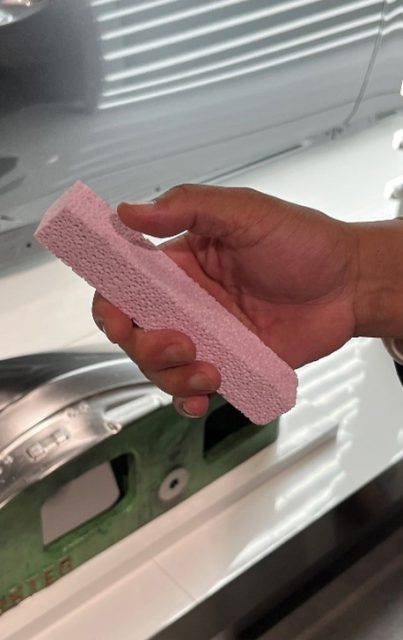
The first generation Kodo whetstone (Photo taken by the writer)
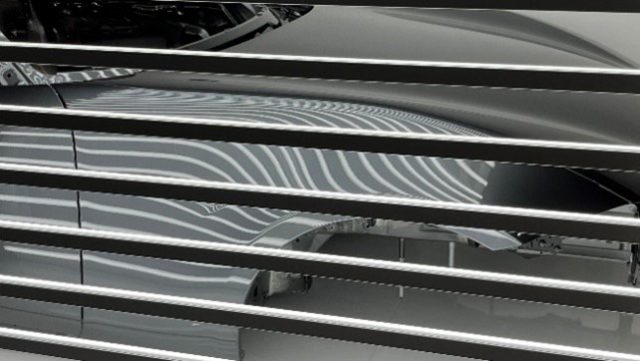
A zebra pattern emerges when Zebra light is applied to plywood (Photo taken by the writer)
Contrivances for elementary and junior high school students
Elementary and junior high school students in Hiroshima are extremely fortunate to be able to visit the museum of one of Japan’s leading companies. Before the COVID-19 pandemic, elementary and junior high school students accounted for nearly half of the approximately 70,000 annual visitors to the museum, and after the renovation commemorating its 100th anniversary, the museum began offering access to sessions given directly by the employees at the front lines, chiefly in development, and engine ignition experiences, giving visitors opportunities to have direct contact with employees on the first Saturday of each month.
Besides the engine ignition experience, there are other ways for the company to contribute to the local community, specifically for elementary and junior high school students. The first is a ride-on experience of a car model currently on sale, displayed at the entrance. Even after COVID, the company continues implementing comprehensive steps against infection according to the infection status and ensures safe rides for children. The team mulled over the decision, aware that parents and guardians would be against having their children sit in the driver’s seat of vehicles at home and at dealerships because of the potential risks. But that was precisely why they decided it was impossible to do away with the excitement of driving when the children visited a museum where safety was guaranteed. It was a decision typical of Mazda, which values the joys of driving, the sensation of touching moving objects, and the thrill of moving a vehicle for the first time.
The second is the Zone, which explains the current process from development to production. The left side of the Zone provides information for adults, while the right side provides information for children. For children, exhibits on environmentally friendly car manufacturing, computer-aided design, panels explaining the development process, designer drawings, and tools are displayed. The production line is next on tour, and elementary and junior high school students who visit can proceed with an understanding of the necessary steps for production and the many people involved.
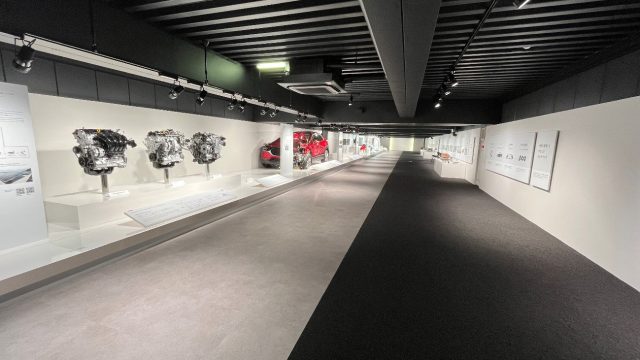
Zone 8, showcasing current technology and process from development to production (Photo taken by the writer)
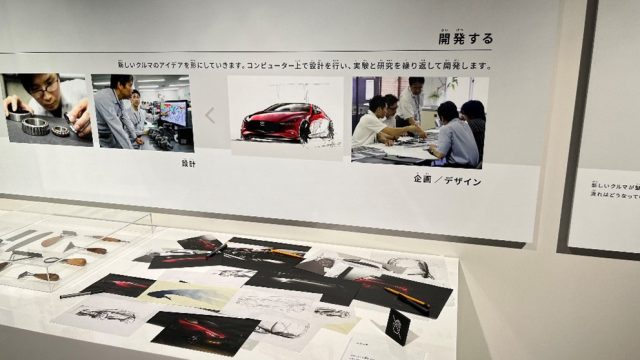
On the right side of the entrance are exhibits that are easy for children to understand (Photo taken by the writer)
Thirdly, Mazda Kids Channel is an information site for children offering an easy-to-understand overview of Mazda’s approach to development, sales, and the environment. The site is a combination of photographs, illustrations, animated videos, and interviews with Mazda employees. In addition, Mazda has also opened an online museum on the occasion of its 100th-anniversary revamping, and videos of the museum taken by drones can also be viewed on the website.
For everyone who loves cars, loves Mazda, and those who don’t
Zone 9 is the production line. It is a mixed production line with many different types of cars on the conveyors, and the sight of the various parts being assembled one after the other is breathtaking. This is the zone where visitors often become the most excited, particularly people who love cars and Mazda. Many visitors appear to be fans of Mazda, saying they drove their Mazda all night to get here or took their driver’s test in an R360 Coupe. Mazda has even heard one person say they appeared in the first Familia (also known as Mazda 323) commercial as a child actor and another that their wife came to marry him in a Luce (also known as Mazda 929) driven by his uncle, which he associates with fond memories.
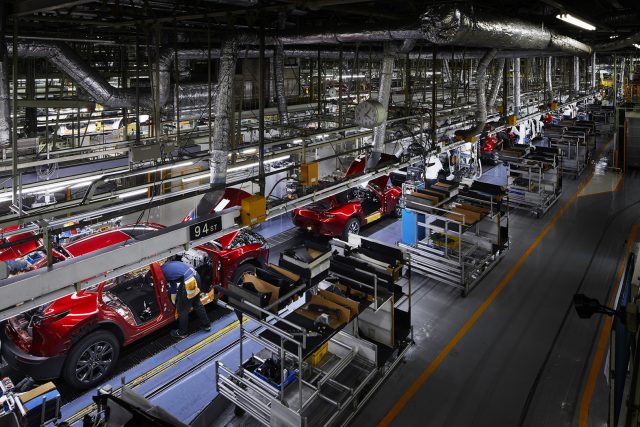
The production line in Zone 9 (Photo courtesy of Mazda Motor Corporation)
However, no small number of people who do not like cars or Mazda are brought to the museum by family or friends. In Zone 10, other items, such as ceramics and sofas with beautiful, sophisticated designs, are displayed. Mazda says visitors who are brought along to the museum and experience these relaxed areas comment on the comfortable setting. In these ways, this museum can be enjoyed by a wide range of people.
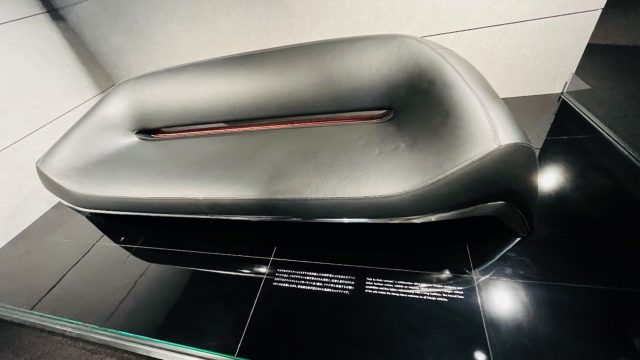
A sofa created jointly by a Mazda designer and an Italian furniture craftsman is also displayed at the museum (Photo taken by the writer)
"Never stop challenging" seen visually deepens empathy
In addition to its efforts to protect the environment and contribute to a safe and secure automotive society, Mazda is also working with academia to verify whether continuous driving effectively maintains and improves cognitive functions. Indeed, Mazda puts into practice the words of Jujiro Matsuda, who supported the company during its early years: “Contribute to society through the power of industry.” Its continuous pursuit of ultimate designs is also a major part of that effort, and by simply standing in the museum, this writer could sense that Mazda wants people, regardless of whether they drive cars or Mazda cars, to be excited by the company’s presence. They will be able to understand that the people who work at Mazda continue their “Never stop challenging,” and the stories presented here will invite deeper empathy with the company. This writer hopes you will experience the world of Mazda here in Hiroshima.

Director Hiroyuki Sukemitsu and museum staff member Yuri Okita stand in front of a Mazda MX-30 (compact SUV) in 100th-anniversary colors. *Sales of 100th-anniversary specification vehicles have ended. (Photo taken by the writer)
